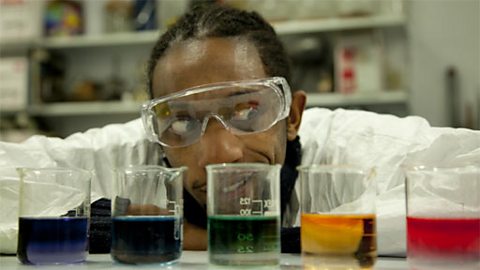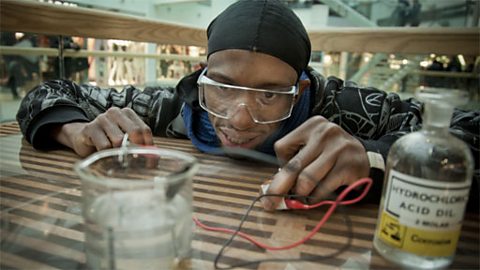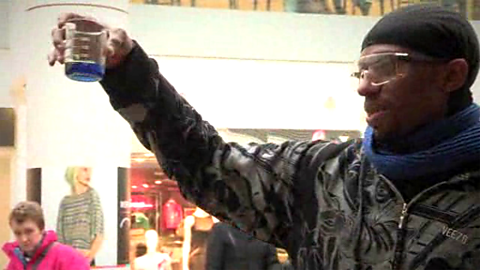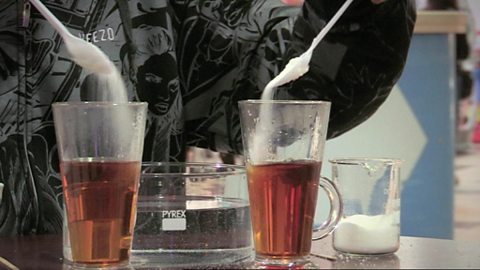JON CHASE:'Chemical reactions are all about collisions between particles, 'and a rate of reaction depends on how frequently particles collide 'and with how much energy.
JON CHASE:'There four methods of increasing the rate of reaction. 'My mate Professor Seller is going to talk me through them.
JON CHASE:'First up - concentration.'
PROFESSOR SELLER:What we're going to do is we're going to set up these three reactions. This one's going to be the high concentration one. You can see there's more stuff in it.
PROFESSOR SELLER:We're going to put medium one, and then finally we're going to have a low concentration one down at the other side.
PROFESSOR SELLER:And this is going to be like a race, we're going to start them off, and when we get to the end of the race, the solution's going to turn blue.
PROFESSOR SELLER:Are you ready?
JON CHASE:Yeah.
PROFESSOR SELLER:Steady? Go.
PROFESSOR SELLER:And now let's just mix them up.
JON CHASE:'The reaction taking place in the beaker 'finishes with the sudden release of iodine.
JON CHASE:'Which interacts with the starch that is already present 'to turn the solution blue, almost instantly.'
PROFESSOR SELLER:We have the reaction going, and what we're doing is we're waiting for those racers to get to the end.
JON CHASE:'Firm favourite is high concentration, 'also in the running is medium concentration.
JON CHASE:'Bringing up the rear is low concentration.'
PROFESSOR SELLER:Woah, there went the first.
JON CHASE:'As expected the firm favourite, high concentration, 'comes storming through the finish line.'
PROFESSOR SELLER:Now what about this one? Kind of wondering whether that one's going to go.
PROFESSOR SELLER:Oh, there went the second one. The runners are coming in exactly in the order that we're expecting.
PROFESSOR SELLER:And that one, he's been out of training or something. That's not-- Oh! There it went.
JON CHASE:'Of the three solutions that were added, 'it was the solution with the highest concentration 'that resulted in the quickest reaction.
JON CHASE:'Because the reactant particles are more crowded, 'collisions take place more frequently.
JON CHASE:'So that was concentration. Now on to temperature.
JON CHASE:'When the temperature is increased, 'the particles in a solution move more quickly.
JON CHASE:'This causes an increase in the frequency of collisions 'and the energy of which they hit each other.'
JON CHASE:We're going to see how temperature affects the rate of reaction. We're going to do that by using a glowstick, which reacts when we break it.
JON CHASE:Now let's see what would happen if you was to cool it down. So as you can see, the reaction gives off light.
JON CHASE:This isn't giving off light so the reaction appears to have slowed down. If we cool it down and the reaction slows down, what happens if we heat it up? Well let's give it a go.
JON CHASE:A bit of friction to heat it up.
JON CHASE:And as we warm up the solution, what happened to the reaction?
JON CHASE:Well it's started to give off light again, even more light than that. And because it's now got warmer, the reaction has sped up. So we can say that increasing temperature speeds up a reaction.
JON CHASE:And decreasing a temperature, slows down a reaction.
JON CHASE:So stick it in your freezer if you want to keep it for tomorrow to have more raving. Right, I'm off.
JON CHASE:'Next up are catalysts. 'They work by speeding up a reaction and they do this 'by increasing the number of successful collisions 'between particles.
JON CHASE:'Back to Professor Seller and his great experiments.'
PROFESSOR SELLER:Here we have hydrogen peroxide and I'm going to add a little bit of a solid catalyst. This is manganese dioxide, tiny bit.
PROFESSOR SELLER:Can you see that the tiny little flecks of manganese dioxide are actually causing the reaction, they're causing the hydrogen peroxide to decompose the oxygen in the water.
JON CHASE:So they're reacting and remaining unchanged now?
PROFESSOR SELLER:Absolutely. Now it's interesting that on this side we've got the same hydrogen peroxide but without the catalyst. And actually it decomposes very, very slowly, even if you leave it in the fridge, eventually it will go off.
PROFESSOR SELLER:Let's not mess around.
PROFESSOR SELLER:Let's give it a real load of catalyst to see what happens.
JON CHASE:Do I have to step back for this?
PROFESSOR SELLER:Well you'll see. Go!
PROFESSOR SELLER:It's actually gotten so hot that it's boiling and you'd see a plume of water vapour which accompanies the oxygen as it comes out.
JON CHASE:'The catalyst is causing the breakdown of hydrogen peroxide 'into water and oxygen at a phenomenal rate, 'but the catalyst has not changed at all throughout this reaction.'
PROFESSOR SELLER:The catalyst is still there. We could pour this all off, we could filter it away and we would collect all of that black stuff, that's our catalyst.
JON CHASE:'And finally - the size of particles. 'How does that affect the rate of reaction?'
JON CHASE:Let's burn this lump of sugar.
JON CHASE:Well it burns a bit.
JON CHASE:As it burns, the sugar is turned into carbon dioxide and water.
JON CHASE:What about if we decrease the particle size using something like icing sugar? Using a smaller particle size increases the surface area.
JON CHASE:We've used the same amount of sugar as is in this cube, and we've put it into this tube.
JON CHASE:Now let's see what happens when we try and burn it this time.
JON CHASE:There was a lot more reacting going on and a lot more heat, I could even feel it coming off.
JON CHASE:'So by breaking down the sugar into a powder, it's surface area increased. 'More of the sugar has been exposed to the oxygen in the atmosphere, 'so collisions can take place more frequently.'
JON CHASE:Decreasing the size of the particle increases the rate of reaction and that's because we have increased the surface area.
JON CHASE:'So let's recap. 'To increase the rate of a reaction - 'the concentration needs to increase, 'or the temperature needs to increase, 'or the size of particles needs to decrease.
JON CHASE:'And the other way to increase the rate of reaction 'is to use a catalyst.'
Science presenter Jon Chase briefly outlines collision theory and then describes four ways to increase the rate of a reaction.
The effect of concentration is demonstrated using an iodine clock reaction.
The effect of temperature is demonstrated using a glowstick.
The effect of a catalyst is demonstrated using hydrogen peroxide and manganese(IV) oxide.
The effect of particle size is demonstrated using the combustion of sugar.
Teacher Notes
This short film could be used as an introduction to rates of reaction. After watching, ask students to summarise their understanding of this important topic using a poster or a series of role-plays which could be peer-assessed.
Students could complete practical investigations into the effect of temperature, concentration, particle size or catalysts.
The iodine clock demonstration can be used to demonstrate the effect of changing concentration or temperature. Search online for ŌĆśRSC CCD iodine clockŌĆÖ.
Curriculum Notes
This short film will be relevant for teaching chemistry and science in general at KS3 and KS4 in England, Wales and Northern Ireland and National 4/5 in Scotland.
More from Chemistry Bites:
Acids and alkalis. video
How carbon dioxide levels in the atmosphere are causing the pH of the oceans to change.

Electrolysis and electroplating. video
A demonstration of electroplating a copper coin with zinc.

Endothermic and exothermic reactions. video
An endothermic reaction and an exothermic reaction are shown and explained.

Solubility, solutes, solvents and solutions. video
Solubility of most solids increases with temperature, unlike most gases which decrease.
